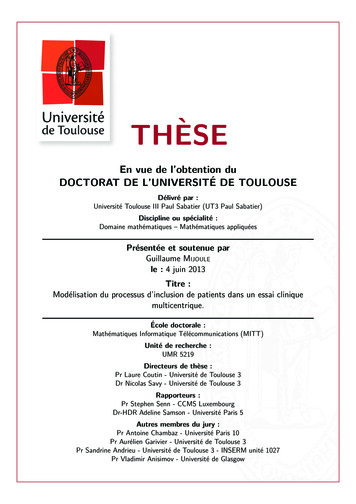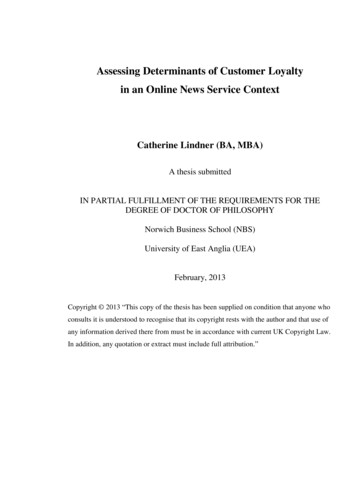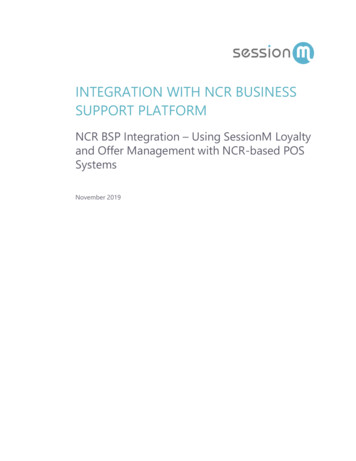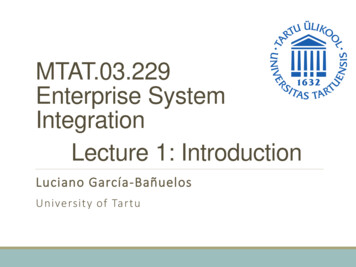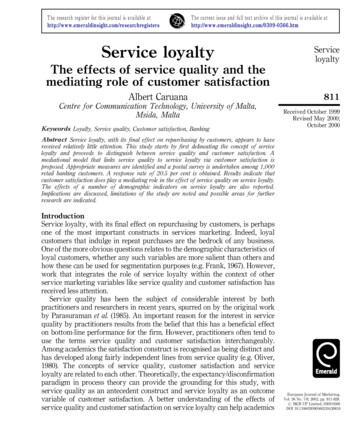
Transcription
T h e rese a rch reg is te r fo r th is jo u rn a l is a v a ila b le a thttp://www.emeraldinsight.com/researchregistersT h e cu rren t iss u e a n d fu ll tex t a rch iv e o f th is jo u rn a l is a v a ila b le a e loyaltyServiceloyaltyThe effects of service quality and themediating role of customer satisfactionAlbert CaruanaCentre for Communication Technology, University of Malta,Msida, MaltaKeywords Loyalty, Service quality, Customer satisfaction, Banking811Received October 1999Revised May 2000;October 2000Abstract Service loyalty, with its final effect on repurchasing by customers, appears to havereceived relatively little attention. This study starts by first delineating the concept of serviceloyalty and proceeds to distinguish between service quality and customer satisfaction. Amediational model that links service quality to service loyalty via customer satisfaction isproposed. Appropriate measures are identified and a postal survey is undertaken among 1,000retail banking customers. A response rate of 20.5 per cent is obtained. Results indicate thatcustomer satisfaction does play a mediating role in the effect of service quality on service loyalty.The effects of a number of demographic indicators on service loyalty are also reported.Implications are discussed, limitations of the study are noted and possible areas for furtherresearch are indicated.IntroductionService loyalty, with its final effect on repurchasing by customers, is perhapsone of the most important constructs in services marketing. Indeed, loyalcustomers that indulge in repeat purchases are the bedrock of any business.One of the more obvious questions relates to the demographic characteristics ofloyal customers, whether any such variables are more salient than others andhow these can be used for segmentation purposes (e.g. Frank, 1967). However,work that integrates the role of service loyalty within the context of otherservice marketing variables like service quality and customer satisfaction hasreceived less attention.Service quality has been the subject of considerable interest by bothpractitioners and researchers in recent years, spurred on by the original workby Parasuraman et al. (1985). An important reason for the interest in servicequality by practitioners results from the belief that this has a beneficial effecton bottom-line performance for the firm. However, practitioners often tend touse the terms service quality and customer satisfaction interchangeably.Among academics the satisfaction construct is recognised as being distinct andhas developed along fairly independent lines from service quality (e.g. Oliver,1980). The concepts of service quality, customer satisfaction and serviceloyalty are related to each other. Theoretically, the expectancy/disconfirmationparadigm in process theory can provide the grounding for this study, withservice quality as an antecedent construct and service loyalty as an outcomevariable of customer satisfaction. A better understanding of the effects ofservice quality and customer satisfaction on service loyalty can help academicsEuropean Journal of Marketing,Vol. 36 No. 7/8, 2002, pp. 811-828.# MCB UP Limited, 0309-0566DOI 10.1108/03090560210430818
EuropeanJournal ofMarketing36,7/8812in the development of a model of service marketing. It can also providepractitioners with indications as to where best to devote marketing attentionand scarce corporate resources.This study seeks to contribute to the development of a conceptualframework that integrates service loyalty, service quality and customersatisfaction. It reviews the literature on these three constructs and outlines theexpected relationships in a research model. Appropriate measures areidentified and research is carried out among retail banking customers to testthe hypothesised relationships. The demographic characteristics of loyalcustomers are also investigated. Implications for theory development andmanagement are discussed.Service loyaltyThe conceptualisation of the loyalty construct has evolved over the years. Inthe early days the focus of loyalty was brand loyalty with respect to tangiblegoods (Cunningham, 1956; Day, 1969; Kostecki, 1994; Tucker, 1964).Cunningham (1956) defined brand loyalty simply as the proportion ofpurchases of a household devoted to the brand it purchased most often’’.Cunningham (1961) was to broaden the spectrum of analysis by focusing onstore as opposed to brand loyalty using the same measures he had used earlierfor brands. Over time the foci have continued to expand, reflecting the widerperspective of marketing to include other types of loyalty such as vendorloyalty. However, few studies have looked at customer loyalty of services(Oliver, 1997). The intention of this section is to show the evolution of theloyalty construct over time, mapping out the construct’s domain and its specificcomponents to provide a clear definition of the service quality construct used inthis study.A review of the literature indicates that much of the initial researchemphasised the behavioural dimension of loyalty. This is epitomised byTucker (1964, p. 32) who holds that:No consideration should be given to what the subject thinks nor what goes on in his centralnervous system, his behaviour is the full statement of what brand loyalty is.A review by Jacoby (1971) confirms that prior studies have focused entirely onbehavioural outcomes and ignored consideration of what went on in customers’minds. Brand loyalty was simply measured in terms of its outcomecharacteristics (Jacoby and Chestnut, 1978). This involved determining thesequence of purchase (Brown, 1952, 1953; Lawrence, 1969; McConnell, 1968;Tucker, 1964), proportion of purchase devoted to a given brand (Cunningham,1956) and probability of purchase (Frank, 1962; Maffei, 1960).Day (1969) argued that there is more to brand loyalty than just consistentbuying of the same brand. Attitudes for instance’’. Building on this work,Jacoby (1969, 1971) provided a conceptualisation of brand loyalty thatincorporated both a behavioural and an attitudinal component. Thebehavioural aspect of loyalty focuses on a measure of proportion of purchase of
a specific brand, while attitude is measured by a single scale (Day, 1969) ormuti-scale items (Selin et al., 1988). Day obtained a value for loyalty by dividingthe ratio of purchase of a brand by the mean scores obtained for attitude. Thebehavioural and attitudinal aspects of loyalty are reflected in the conceptualdefinition of brand loyalty offered by Jacoby and Chestnut (1978). Theseauthors hold that:Brand loyalty is (1) biased (i.e. non random), (2) behavioural response (i.e. purchase), (3)expressed over time, (4) by some decision making unit, (5) with respect to one or more brandsout of a set of such brands, and is a function of psychological processes.Much of the work on loyalty in the 1970s and early 1980s has used thisconceptualisation (cf. Goldberg, 1981; Lutz and Winn, 1974; Snyder, 1986).More recently, Dick and Basu (1994) suggest an attitudinal theoreticalframework that also envisages the loyalty construct as being composed of relative attitude’’ and patronage behavior’’.A further aspect of loyalty identified by other researchers in more recentyears is cognitive loyalty. This is seen as a higher order dimension andinvolves the consumer’s conscious decision-making process in the evaluation ofalternative brands before a purchase is effected. Gremler and Brown (1996)extend the concept of loyalty to intangible products, and their definition ofservice loyalty incorporates the three specific components of loyaltyconsidered, namely: the purchase, attitude and cognition. Service loyalty isdefined as:The degree to which a customer exhibits repeat purchasing behavior from a service provider,possesses a positive attitudinal disposition toward the provider, and considers using only thisprovider when a need for this service exists (Gremler and Brown, 1996).Service qualityDefinitions of service quality hold that this is the result of the comparison thatcustomers make between their expectations about a service and theirperception of the way the service has been performed (Lewis and Booms, 1983;Lehtinen and Lehtinen, 1982; Grönroos, 1984; Parasuraman et al., 1985, 1988,1994). Lehtinen and Lehtinen (1982) give a three-dimensional view of servicequality. They see it as consisting of what they term interaction’’, physical’’and corporate’’ quality. At a higher level, and essentially from a customer’sperspective, they see quality as being two-dimensional, consisting of output’’and process’’ quality. The model proposed by Grönroos (1984, 1990) highlightsthe role of technical (or output) quality and functional (or process) quality asoccurring prior to, and resulting in, outcome quality. In this model technicalquality refers to what is delivered to the customer, be it the meal in a restaurant,the solution provided by a consultant, or the home identified by the estateagent. Functional quality is concerned with how the end result of the processwas transferred to the customer. This concerns both psychological andbehavioral aspects that include the accessibility to the provider, how serviceemployees perform their task, what they say and how the service is done. ThusServiceloyalty813
EuropeanJournal ofMarketing36,7/8814while technical quality can often be quite readily evaluated objectively, this ismore difficult to do with functional quality. The model also recognises thatcustomers also have some type of image of the firm, which has a quality impactin itself and functions as a filter. The customers’ perceived quality is the resultof the evaluation they make of what was expected and what was experienced,taking into account the influence of the organisation’s image.In operationalising the service quality construct, Parasuraman et al. (1985,1988, 1994) have made use of qualitative and quantitative research followinggenerally accepted psychometric procedures. This resulted in the developmentof the original 22-item SERVQUAL instrument that represents one of the mostwidely used operationalisations of service quality. It has provided researcherswith the possibility of measuring the performance-expectations gap (gap 5)ostensibly composed of five determinants. In further developing theexpectations side of their gap model, Berry and Parasuraman (1991) andZeithaml et al. (1993) argue that expectations can be conceptualised to exist attwo levels: the desired; and the adequate. In between there exists a zone oftolerance reflecting the degrees of heterogeneity individual customers arewilling to accept. Interestingly, the original service quality gap (gap 5) nowsplits into two (Zeithmal et al., 1993). Gap 5A results from the contrast betweenperceived service and desired service and is termed the measure of servicesuperiority (MSS). Gap 5B contrasts perceived service with adequate serviceand is termed the measure of service adequacy (MSA). The authors argue thatcompanies providing a service above the adequate level have a competitiveadvantage. However, such companies need to strive so that perceived serviceexceeds the service level desired by customers. This will ensure customerfranchise’’ which results in unwavering customer loyalty.The contention by the developers of SERVQUAL that the instrument can beapplied to determine the service quality offering of any service firm has led toits extensive adoption (cf. Dabholkar et al., 1996). The various replicationsundertaken have highlighted a number of areas of both theoretical andpsychometric concern. First, the conceptualisation and usefulness of theexpectations side of the instrument has been questioned (cf. Boulding et al.,1993; Cronin and Taylor, 1992, 1994; Forbes et al., 1986; Tse and Wilton, 1988).Second, the problems expectation scores pose in terms of variance restrictionhave been highlighted (cf. Babakus and Boller, 1992; Brown et al., 1993). Third,there are problems associated with difference scores including findingsshowing that the performance items on their own explain more variance inservice quality than difference scores (Babakus and Boller, 1992; Cronin andTaylor, 1992, 1994). Cronin and Taylor (1992, 1994) show empirically that theperception items in SERVQUAL exhibit a stronger correlation with servicequality than the difference score computations suggested by SERVQUAL.They therefore suggest the use of SERVPERF that consists solely of the 22performance items of SERVQUAL. Finally, the number of factors extracted isnot stable (cf. Bouman and van der Wiele, 1992; Carman, 1990; Cronin andTaylor, 1992, 1994; Gagliano and Hathcote, 1994).
In response to the empirical findings that have emerged, Parasuraman et al.(1994) have undertaken significant changes. First, there has been areconceptualisation and extension of the expectations side distinguishingbetween desired and minimum expectations. Second, they have suggested theuse of a three-column format SERVQUAL that eliminates the need tore-administer items. The authors have also suggested a reduction in thenumber of items to 21, the use of nine-point instead of seven-point scales, andrecognise the possibility of the existence of three rather than five dimensions,where responsiveness, assurance and empathy meld into a single factor’’.The Grönroos and the gap model of service quality provide parallelconceptualisation of the construct. The contribution made by Parasuraman etal. has been in developing the widely used SERVQUAL. Cronin and Taylor(1992, 1994) have shown that SERVPERF does a better job in measuringservice quality. This paper takes the view that the conceptualisation of servicequality as a gap is correct, but adopts the position by Rust et al. (1996, p. 249)who hold that service quality is simply confirmation/disconfirmation insatisfaction theory. Operationally this means that the gap is measured directlyby asking respondents to provide a score for each of the performance items inSERVQUAL in relation to their expectations rather than ask these separatelyand then calculating the gap. This preserves the conceptualisation of servicequality but has the advantage of being more statistically reliable and cuttingthe length of the questionnaire.Customer satisfactionThe expectancy/disconfirmation paradigm in process theory (Mohr, 1982)provides the grounding for the vast majority of satisfaction studies andencompasses four constructs:(1) expectations;(2) performance;(3) disconfirmation; and(4) satisfaction.Dis/confirmation arises from discrepancies between prior expectations andactual performance. This conceptualisation is reflected in the definition ofsatisfaction by Tse and Wilton (1988, p. 204) as:The consumer’s response to the evaluation of the perceived discrepancy between priorexpectations (or some norm of performance) and the actual performance of the product asperceived after its consumption.At face value this definition is very similar to that put forward for servicequality. However, a number of distinctions are often made between customersatisfaction and service quality. These include that satisfaction is a postdecision customer experience while quality is not (Bolton and Drew, 1991;Boulding et al., 1993; Cronin and Taylor, 1994; Oliver, 1980, 1993; Parasuramanet al., 1988). A further point concerns expectations that are defined differentlyServiceloyalty815
EuropeanJournal ofMarketing36,7/8816in the satisfaction and quality literature. In the satisfaction literature expectations reflect anticipated performance’’ (Churchill and Suprenant, 1982,p. 492) made by the customer about the levels of performance during atransaction. On the other hand, in the service quality literature, expectationsare conceptualised as a normative standard of future wants (Boulding et al.,1993, p. 8). These normative or ideal standards represent enduring wants andneeds that remain unaffected by the full range of marketing and competitivefactors. Normative expectations are therefore more stable and can be thought ofas representing the service the market oriented provider must constantly striveto offer (Zeithaml et al., 1993).One of the hurdles in looking at antecedents and consequences of customersatisfaction is the absence of a consensus as to what constitutes satisfaction.Without a clear and broadly accepted conceptual and operational definition thedevelopment of satisfaction measurement instruments is somewhat arbitrary,and any conclusions about interactions with other constructs are problematic.To identify the conceptual domain of the customer satisfaction construct, Gieseand Cote (2000) conduct research that involves a review of the satisfactionliterature together with group and personal interviews. They define thecustomer as the ultimate user of a product. Their research suggests threegeneral components that constitute the customer satisfaction construct. First,customer satisfaction is a summary affective response that varies in intensity.Second, the response pertains to a particular focus, be it a product choice,purchase or consumption. Finally, the response occurs at a particular time thatvaries by situation, but is generally limited in duration. The authors hold thatthese three aspects provide a framework for a context specific operationaldefinition. They describe customer satisfaction as:A summary affective response of varying intensity, with a time-specific point ofdetermination and limited duration, directed toward focal aspects of product acquisition and/or consumption.This definition can be used to develop context relevant definitions. For thepurpose of this study the definition of customer satisfaction with retail bankingservices:Involves a post purchase, global affective summary response, that may be of differentintensities, occurring when customers are questioned and undertaken relative to the retailbanking services offered by competitors.Research modelThere has been significant effort in the past to look at the area of servicequality, customer satisfaction and, to a lesser extent, service loyalty. However,there is considerable confusion in the demarcation between service qualityand customer satisfaction. Grönroos (1984, 1990) and Parasuraman et al.(1985, 1988, 1994), both argue that perceived service quality results from thecomparison that customers make between expected quality and experienced oroutcome quality. The expectancy/disconfirmation paradigm that ultimately
results in satisfaction or dissatisfaction makes a similar point. Use is made ofthis paradigm in process theory to accommodate both the Grönroos and thegap model.It is clear from Grönroos (1984) that the most important aspect to perceivedservice quality is the functional rather than the technical side of quality. Thegap model and its resultant SERVQUAL measure primarily focus on whatGrönroos (1984, 1990) terms the functional aspect of quality. It is suggestedthat these two models represent parallel concepts that can both be viewed asone type of confirmation/disconfirmation in satisfaction theory. It is for thisreason that we adopt the suggestion by Rust et al. (1996, p. 249) who argue thatservice quality is simply confirmation/disconfirmation and who advocate thedirect measurement of the perception items in SERVQUAL in relation torespondents’ expectations. On its own the gap model has no theoreticalgrounding and the use of difference score measures relative to idealexpectations is questionable. The approach being suggested has the advantageof providing a clearer theoretical underpinning to the constructs, data that aremore statistically reliable while cutting the length of the questionnaire.As a process in time, service quality takes place before, and leads to, overallcustomer satisfaction. Although Cronin and Taylor originally hypothesisedthat satisfaction is an antecedent of service quality, their research with a multiindustry sample showed, in a LISREL analysis, an opposite relationship.Service quality appears to be only one of the service factors contributing tocustomers’ satisfaction judgements (Cronin and Taylor, 1992; Ruyter et al.,1997; Spreng and Mackoy, 1996). There are clearly other antecedents.Overall satisfaction with an experience does lead to customer loyalty.Bearden and Teel (1983) argue that customer satisfaction is important to themarketer because it is generally assumed to be a significant determinant ofrepeat sales, positive word of mouth and consumer loyalty’’. Similarly, Bloemerand Poiesz (1989) have also argued that satisfaction can be thought of as animportant determinant of brand loyalty’’, while Selnes (1993) argues that it issatisfaction with a brand that leads to customer loyalty. This view is alsosupported by Dick and Basu (1994). LaBarbera and Mazursky (1983) showempirically that brand loyal customers had a lower probability to switchbrands due to higher levels of satisfaction. On the basis of the above, customersatisfaction is indicated as acting as a mediator in the link between servicequality and service loyalty as per Figure 1.Baron and Kenny (1986, p. 1177) provide the procedure that can be used toinvestigate the mediating effect depicted in Figure 1. This involves thecomputation of three regression equations: first, the regression of the mediator(customer satisfaction) on the independent variable (service quality), second,the regression of the dependent variable (service loyalty) on the independentvariable (service quality); and third, the regression of the dependant variable(service loyalty) on both the independent variable (service quality) and on themediator (customer satisfaction). For mediation to hold: in the first regressionequation the independent variable must affect the mediator; in the secondServiceloyalty817
EuropeanJournal ofMarketing36,7/8818Figure 1.Research modelequation the independent variable must be shown to affect the dependentvariable; and in the final equation the mediator must affect the dependentvariable to the exclusion of the independent variable.The researchThe questionnaire used consisted of 37 items split between three instrumentsthat each measured service loyalty, service quality and customer satisfactionrespectively. Demographic variables were also collected. To measure serviceloyalty the 12-item measure suggested by Gremler and Brown (1996) thatcaptures their conceptualisation of service loyalty has been used. Seven-pointscales described at either end by strongly agree’’ and strongly disagree’’ wereused. To measure service quality the 21-item SERVQUAL instrument wasused. However, in line with the conceptualisation envisaged, rather than collectexpectation and perception items separately, service quality is treated asdisconfirmation in satisfaction theory, and perceptions data relative torespondent expectations are collected directly. Therefore, for each perceptionitem respondents were asked to consider their views in terms of theirexpectations on a three-point scale. Was the perception on the particular itemworse than expected, about as expected or better than expected? To measurecustomer satisfaction the instrument provided by Bitner and Hubbert (1994)was used. This is in line with the conceptualisation of customer satisfactionadopted. The instrument consists of a four-item scale that looks at postpurchase, global affective summary responses measured using a five-pointLikert-type scale appropriately described at either end. The wordings of theitems, together with descriptive statistics, appear in the Appendix.Postal questionnaires were undertaken because of consideration of costs. Itis known that almost all households in Malta have a bank account and use wastherefore made of the telephone directory as a convenient sampling frame. The critical sample size’’ for the intended subsequent LISREL analysis isconsidered to be 200 replies (Hair, 1998, p. 605). Since the reply rate foranonymous postal surveys in Malta is in the region of 23 per cent, mailings
were sent to 1,000 households generated at random from an electronic versionof the telephone directory that excluded commercial subscribers. The coveringletter sought to generate interest, reassure potential respondents of theminimum effort required in replying, and provided an undertaking ofanonymity. By the closing date, three weeks later, 194 replies were received.Given that 52 of the original questionnaires were returned for various reasons,an acceptable response rate of 20.5 per cent was achieved. To test for nonresponse bias use was made of the technique suggested by Armstrong andOverton (1977). This assumes that late respondents are similar to nonrespondents. t-tests were used to compare the means for each of the items of thelast 30 replies received to the mean for the same items from the rest of therespondents. Differences were not statistically significant and this was treatedas sufficient assurance that the data obtained were likely to be a fairrepresentation of the population of interest.ResultsRespondents were almost equally split between males (43.8 per cent) andfemales, 73.2 per cent were married and 12.4 per cent were single. The meanage was 43 (SD 15.6) and 73.2 per cent of respondents had completed up tosecondary level of education. The check for reliability provided (Cronbach,1951) alphas that ranged from 0.79 to 0.95, which exceeded the acceptable cutoff point of 0.70 (Nunnally, 1978). The third customer satisfaction item (item 24in the Appendix) was deleted as this has an item-to-total correlation of less than0.5. The Appendix provides loadings resulting from a simultaneous factoranalysis followed by a varimax rotation of all the items of the three constructsthat make up the questionnaire. Results show a clear factor structure. Theservice loyalty and customer satisfaction items load on two separate factors,while the service quality items load on three factors. The loading of the servicequality items is in line with the latest findings by Parasuraman et al. (1994).The responsiveness, assurance and empathy items melding into one factor anddistinct factors for tangibles and reliability arise. Also in line with recentfindings, SERVQUAL item 6 (item 22 in the Appendix) that had previouslybeen treated as a responsiveness item tends to load with the reliability items.The loading results in the Appendix provide support for both convergent anddiscriminant validity, with items expected to load together actually doing so.The results of the regression equations required to test the mediation modelare shown in Table I. The conditions required for mediation to hold are present.The effect of service quality on the service loyalty is much less in the thirdequation than in the second and the R has improved. Although perfectmediation cannot be claimed as the beta for service quality in the third equationis still significant (at p 0.05), a mediation effect can be confirmed as the betavalue has declined very considerably. Service quality acts on service loyalty viacustomer satisfaction. As can be expected, service quality and customersatisfaction are correlated (r 0.45; p 0.00), resulting in multicollinearity, andthis is compounded by the possible presence of measurement error in theServiceloyalty819
EuropeanJournal ofMarketing36,7/8820results. To overcome these concerns structural equation modelling can be used.This has the advantage of taking all the relevant paths being tested directlyand dealing with complications of measurement error, correlated measurementerror and even feedback that are incorporated directly into the model (Baronand Kenny, 1986). To do this the model in Figure 1 was used as the basis of aLISREL 8.3 (Jöreskog et al., 1999) analysis. The results provided a very good fit(À2 (3) 2.24; p 0.52; GFI 0.98) and standardised beta values that are veryclose to those obtained from the multiple regression (Table II). The majordifference is that the marginal decline in the value of the beta for the linkbetween service quality and service loyalty is enough to render this linknon-significant. The LISREL analysis can be considered to be a more robusttest of the interrelationship among constructs, and the results obtained providesupport for a completely mediated effect of service quality on service loyaltyvia customer satisfaction.Means for each of the constructs were tested against classificatory variables.Statistically significant lower mean scores were obtained for the threeconstructs as the education level of respondents increases (Table III). Results ofa further ANOVA also shows statistically significant differences between agegroups for all constructs, with younger respondents tending to give lowerscores (Table IV). Results of t-tests and an ANOVA for gender and maritalstatus, respectively, indicated no statistically significant differences.To investigate which elements of age or education play the most salienteffect, the service loyalty construct was investigated further as this isultimately what determines defection or repurchases. To do this analysisyTable I.Results of regressionequations testingmediationCustomer satisfactionService loyaltyService 69.30***0.15*0.57***R2FBeta – service qualityBeta – customer satisfactionNote: Betas reported are standardised values*** p 0.000; * p 0.05ParameterGammaService quality ! customer satisfactionTable II.ML estimates forstructural modelparametersBetaCustomer satisfaction ! service loyaltyService quality ! service loyaltyNote: *** p .670.537.04***0.590.170.590.148.44***1.91
CHAID (chi-squared automated interaction detector) was applied to the data.The results in tree diagram form are depicted in Figure 2. These show that62.5 per cent of respondents are less loyal. Education is the primary variablethat explains the pre
loyalty and proceeds to distinguish between service quality and customer satisfaction. A mediational model that links service quality to service loyalty via customer satisfaction is proposed. Appropriate measures are identified and a postal survey is undertaken among 1,000 retail banking customers. A response rate of 20.5 per cent is obtained.


